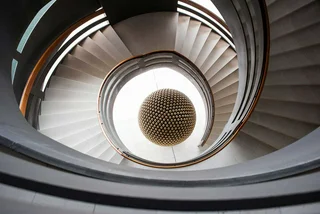The International Hotel in Prague 6 has reopened a rooftop bar with views in all directions. The Grand Bar International was once a meeting place for Prague’s notable figures but it has been closed for four decades – until now.
The renovation of the Grand Bar is part of a larger project to restore the unique International Hotel to its former grandeur. The entire venue has been rebranded as the Grand Hotel International Prague. Completed in 1956, the building is the city’s only example of ornate socialist realist architecture from that decade.
What can you see?
To the south, you can see Prague Castle from an unusual angle. Looking northeast, you find the Prague Zoo. In the east and west, there are large parks mixed in with residential buildings. But the main attraction is the bar's interior, a snapshot of style from the previous century.


The hotel was meant to be the most luxurious in Czechoslovakia, and one of the few places that foreigners could stay. The bar also attracted local celebrities; in its heyday in the 1950s and 1960s, frequent guests, for example, included actor Jan Werich and his entourage.
The highlight of the bar is a mosaic by Czech painter Max Švabinský, whose other credits include designs for Czechoslovak paper money and a stained-glass window in St. Vitus’s Cathedral. Many other artists and craftspeople contributed details including a massive chandelier. Metal outlines of bunches of grapes are a running motif on the stair railings, hinting at the wine available at the bar.


The bar will be open daily until late. Filip Dlesk, the new director of Grand Hotel International, said that a significant part of the clientele will be hotel guests, but the bar will also be open to the public. There will be a modest entry fee to ensure the Grand Bar remains an exclusive place.

One of the hotel's most notable features is a five-pointed star on top of a spire in the middle of the central tower. At first, the star was red, but it has changed color several times over the years and was even removed for a while. It is now back and sporting a golden tone.
While the hotel has always exuded an air of luxury, the earliest concept was rather utilitarian. It was intended as housing for out-of-town military officers, although in reality it never served this purpose. Before construction started, the plans were repurposed for civilian use with rooms that were above the standards of the time instead of military barracks.


The hotel played a minor role in Czechoslovak history. It was where foreigners, including the cast of the film The Bridge at Remagan, were brought together during the 1968 Soviet-led invasion. Actors Robert Vaughn and Ben Gazzara both describe the events at the hotel in their memoirs. Still, there are remnants of an anti-nuclear bunker in the basement, which would have been capable of housing 600 people for two weeks. It is now used for storage.












 Reading time: 2 minutes
Reading time: 2 minutes 


























